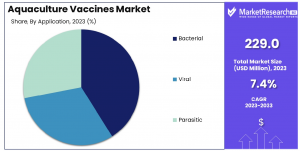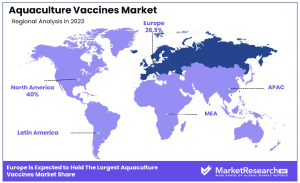
Aquaculture Vaccines Market To Surge To USD 459.3 Million By 2033, Driven By Increasing Focus On Aquatic Animal Health
Global Aquaculture Vaccines Market was valued at USD 229.0 million in 2023. It is expected to reach USD 459.3 million by 2033, with a CAGR of 7.4%
NEW YORK, NY, UNITED STATES, February 10, 2025 /EINPresswire.com/ -- Overview
New York, NY – February 10, 2025 – The Global Aquaculture Vaccines Market was valued at USD 229.0 million in 2023. It is expected to reach USD 459.3 million by 2033, with a CAGR of 7.4% during the forecast period from 2024 to 2033.
Aquaculture vaccines play a critical role in safeguarding the health of farmed fish and other aquatic species, reducing disease outbreaks, and ensuring sustainable seafood production. These vaccines help prevent bacterial, viral, and parasitic infections, which are major challenges in aquaculture, causing significant economic losses and affecting food security.
The rising demand for disease-free fish and environmentally friendly farming practices is driving the adoption of aquaculture vaccines. Unlike antibiotics, vaccines provide long-term immunity without contributing to antibiotic resistance, making them a preferred solution in modern aquaculture. Governments and regulatory bodies are supporting vaccination programs to promote biosecurity and improve aquaculture productivity.
Technological advancements, such as oral and immersion vaccines, are making vaccination processes more efficient and stress-free for fish. Key players in the industry are investing in research and development to introduce new, targeted vaccines that enhance disease prevention.
With global aquaculture production increasing, the need for effective disease control solutions is becoming more urgent. The continued development and adoption of aquaculture vaccines will play a crucial role in improving fish health, reducing mortality rates, and supporting the sustainable growth of the aquaculture industry worldwide.
Unlock Competitive Advantages With Our PDF Sample Report @ https://marketresearch.biz/report/aquaculture-vaccines-market/request-sample/
Key Takeaways
•Market Growth: The global aquaculture vaccines market was valued at USD 229.0 million in 2023 and is projected to reach USD 459.3 million by 2033, growing at a CAGR of 7.4% from 2024 to 2033.
•By Product: Inactivated vaccines lead the market with a 35.2% share, reflecting their effectiveness in disease prevention.
•By Route of Administration: Injection-based administration remains dominant, accounting for 37.3% of usage due to its high efficacy.
•By Application: Bacterial control is the primary focus, holding a 44.2% market share as bacterial infections pose major threats to aquaculture health.
•Regional Dominance: Europe experienced significant market expansion, with a 26.5% surge in aquaculture vaccine adoption.
•Growth Opportunity: The market witnessed strong growth in 2023, driven by government initiatives promoting aquatic health management and increasing consumer demand for safe seafood products.
Segmentation Analysis
•Product Analysis: Inactivated vaccines led the market with a 35.2% share in 2023, highlighting their widespread adoption due to reliability and effectiveness. These vaccines use killed pathogens to trigger immunity without causing disease. Attenuated live vaccines follow, offering strong immune responses with single-dose administration. Subunit, DNA, and recombinant vaccines are emerging as safer and advanced alternatives, signaling a shift toward biotechnology-driven solutions in aquaculture disease prevention.
•Route of Administration Analysis: Injected vaccines dominated the market with a 37.3% share in 2023, due to their precise dosage and strong immune response. Their effectiveness across various aquatic species makes them the preferred method. Oral vaccines are gaining traction for their convenience and stress-free administration. Immersion and spray vaccines, while less dominant, remain vital for smaller aquatic species and early life stages, ensuring broad disease protection.
•Application Analysis: Bacterial vaccines held the largest share (44.2%) in 2023, addressing major bacterial infections such as Aeromoniasis and Streptococcosis, which threaten aquaculture productivity. Viral vaccines are also widely used to prevent infections like Infectious Salmon Anemia Virus (ISAV) and Viral Hemorrhagic Septicemia Virus (VHSV). Parasitic vaccines, though a smaller segment, target sea lice and protozoa, helping improve fish health and overall farm efficiency.
By Product
•Inactivated Vaccines
•Attenuated Live Vaccines
•Subunit Vaccines
•DNA Vaccines
•Recombinant Vaccines
By Route Of Administration
•Injected
•Oral
•Immersion & Spray
By Application
•Bacterial
•Viral
•Parasitic
Buy This Premium Research Report : https://marketresearch.biz/purchase-report/?report_id=46002
Market Dynamics
•Driver: The expansion of the aquaculture vaccines market is primarily driven by the increasing prevalence of infectious diseases in farmed fish populations. As aquaculture intensifies to meet global seafood demand, fish are often reared in high-density environments, which can facilitate the rapid spread of pathogens. Implementing effective vaccination programs has become essential to mitigate these disease outbreaks, reduce mortality rates, and ensure sustainable production. Consequently, there is a heightened demand for vaccines that can prevent common diseases, thereby supporting the growth of the aquaculture industry.
•Trend: A notable trend in the aquaculture vaccines market is the shift towards developing vaccines that can be administered orally or through immersion. Traditional injection methods are labor-intensive and stressful for fish, especially in large-scale operations. Oral and immersion vaccines offer a more efficient and less invasive means of immunization, allowing for the simultaneous vaccination of large numbers of fish. This approach not only reduces handling stress but also enhances overall farm productivity. Research is ongoing to improve the efficacy and stability of these vaccine formulations to broaden their application across various fish species.
•Restraint: Despite advancements, the aquaculture vaccines market faces challenges such as the high cost and lengthy development timelines associated with vaccine production. Developing vaccines that are effective across diverse fish species and adaptable to various farming conditions requires substantial investment in research and rigorous testing to ensure safety and efficacy. Additionally, regulatory approval processes can be complex and time-consuming, potentially delaying the introduction of new vaccines to the market. These factors can limit the availability of vaccines, particularly for small-scale farmers, and may impede the overall growth of the market.
•Opportunity: The increasing global demand for seafood presents a significant opportunity for the aquaculture vaccines market. As wild fish stocks face overexploitation, aquaculture has become a vital source of seafood supply. Ensuring the health and productivity of farmed fish through effective vaccination programs is crucial to meet this demand sustainably. Moreover, growing consumer awareness regarding food safety and the environmental impacts of aquaculture practices is driving the industry towards adopting more responsible and sustainable methods, including the use of vaccines to reduce reliance on antibiotics and minimize disease-related losses.
Emerging Trends in Aquaculture Vaccines
•Innovative Vaccine Technologies: Recent developments have led to the creation of new types of vaccines, such as DNA vaccines and recombinant vaccines. These vaccines have shown promise in effectively preventing diseases in fish, thereby reducing the reliance on antibiotics and supporting more sustainable aquaculture practices.
•Enhanced Delivery Methods: Traditional vaccine administration methods, like injections, can be labor-intensive and stressful for fish. Innovations in delivery methods, including oral vaccines and immersion techniques, are being explored to facilitate mass immunization, making the process more efficient and less stressful for the fish.
•Focus on Sustainable Practices: There is a growing emphasis on developing vaccines that not only protect fish health but also align with environmental sustainability. This includes reducing the use of antibiotics and minimizing the environmental impact of aquaculture operations.
Use Cases of Aquaculture Vaccines
•Prevention of Vibriosis in Salmon: Vibriosis, caused by Vibrio bacteria, has historically led to significant losses in salmon farming. The introduction of vaccines against vibriosis has resulted in a substantial decrease in disease incidence, contributing to the industry's growth.
•Control of Streptococcosis in Tilapia: Streptococcosis is a major concern in tilapia farming, leading to high mortality rates. Vaccination programs have been implemented to control this disease, resulting in improved fish health and reduced economic losses.
•Mitigation of Piscirickettsiosis in Salmonids: Piscirickettsiosis, caused by Piscirickettsia salmonis, has been a significant challenge in salmon farming, particularly in Chile. The development and application of vaccines have been part of integrated strategies to manage this disease, contributing to better fish survival rates.
Lawrence John
Prudour
+91 91308 55334
Lawrence@prudour.com
Distribution channels: Healthcare & Pharmaceuticals Industry
Legal Disclaimer:
EIN Presswire provides this news content "as is" without warranty of any kind. We do not accept any responsibility or liability for the accuracy, content, images, videos, licenses, completeness, legality, or reliability of the information contained in this article. If you have any complaints or copyright issues related to this article, kindly contact the author above.
Submit your press release


